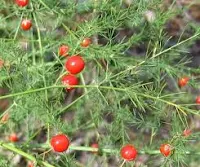 |
| Buy Lemon Balm |
Bot. name : Melissa officinalis
Family : Labiatae or Mint Family
Parts used : Whole plant/Leaves
Chemical composition : The main chemical components are trans-ocimene, cis-ocimene, 3-octanone, methyl hepenone, cis-3-hexenol, 3-octanol, 1-octen-3-ol, copaene, citronellal, linalool, b-bourbonene, caryophyllene, a-humulene, neral, germacrene-D, geranial, geranyl acetate, d-cadinene, y-cadinene, nerol and geraniol.
Common Uses : Beauty , Cardiovascular, Colds, Depression, Herpes, Hypertension, Insect Bites, Nausea, Pregnancy, Sore Throat, Sunburns
Properties : Anodyne, Antispasmodic, AntiViral, Aromatic, Cardic tonic Cordial, Carminative, Diaphoretic/sudorific, Digestive, Emmenagogue, Febrifuge, Hypotensive, Nervine, Sedative, Stomachic, Uterine Tonic,Vermifuge.
Medicinal use of Lemon Balm : Lemon balm is a commonly grown household remedy with a long tradition as a tonic remedy that raises the spirits and lifts the heart. Modern research has shown that it can help significantly in the treatment of cold sores. The leaves and young flowering shoots are antibacterial, antispasmodic, antiviral, carminative, diaphoretic, digestive, emmenagogue, febrifuge, sedative, and tonic. It also acts to inhibit thyroid activity. An infusion of the leaves is used in the treatment of fevers and colds, indigestion associated with nervous tension, excitability and digestive upsets in children, hyperthyroidism, depression, mild insomnia, headaches etc. Externally, it is used to treat herpes, sores, gout, insect bites and as an insect repellent. The plant can be used fresh or dried, for drying it is harvested just before or just after flowering. The essential oil contains citral and citronella, which act to calm the central nervous system and are strongly antispasmodic. The plant also contains polyphenols, in particular these combat the herpes simplex virus which produces cold sores. The essential oil is used in aromatherapy. Its keyword is "Female aspects". It is used to relax and rejuvenate, especially in cases of depression and nervous tension.
Description of the plant
Plant : Perennial
Height : 70 cm (2 feet)
Flovering : June to October
Scent : Scented
Edible parts of Lemon Balm : Leaves - raw or cooked. A pleasant lemon-like aroma and flavour, they are used mainly as a flavouring in salads and cooked foods. A lemon-flavoured tea can be made from the fresh or dried leaves. A bunch of the leaves can be added to china tea, much improving the flavour, the leaves are also added to fruit cups etc. They are used as a flavouring in various alcoholic beverages including Chartreuse and Benedictine.
Other uses of the herb : The growing plant is said to repel flies and ants. It is also rubbed on the skin as a repellent, though the essential oil would be more effective here. An essential oil is obtained from the plant (the exact part is not specified, it is probably the entire plant and especially the flowering stems). It is used medicinally. The whole plant is very pleasantly aromatic, the aroma lasting for a long time after the plant has been harvested. It is therefore a very useful ingredient in pot-pourri.
Propagation of Lemon Balm : Seed - sow spring or autumn in a cold frame. Germination can be slow. Prick out the seedlings into individual pots as soon as they are large enough to handle and plant out into their permanent positions when the plants are at least 15cm tall. If there is plenty of seed it can be sown in an outdoor seed bed in April. Plant out into their permanent positions the following spring. Division in spring or autumn. Very easy, larger clumps can be replanted direct into their permanent positions, though it is best to pot up smaller clumps and grow them on in a cold frame until they are rooting well. Plant them out in the spring. Cuttings in July/August.
Cultivation : Planting is usually 40,000 plants/Ha. with propagation from seed or cuttings. The plants have a life of 10 years but are usually replaced every five years with crop rotation to rejuvenate the soil. Propagation in the northern hemisphere is from April to July.
Harvesting period : In the first year the crop is in August, thereafter two crops are experienced. The first in June and the second in August.
Harvesting methods : Usually by hand on a clear warm day as the leaves will turn black if harvested wet. For good appearance leaves should not be left in the sun.
Pre-Treatment : Weed control is recommended (Pank). It has been reported that, in Egypt, irradiating seeds has an effect on growth, essential oil content and composition. The quantity of herb was reduced but the oil content was increased, with the irradiation dosage varying the proportion of the constituents.
Preservation and Storage : The oil should be stored in filled sealed containers, out of light and kept cool. The oil is subject to oxidation.
Lemon Balm -Melissa Officinalis seeds/leaves are available at :
The Jammu and Kashmir Medicinal Plants Introduction Centre
Meet to us at :"Ginkgo House", Azizabad, Nambalbal, (Via Wuyan-Meej Road), Pampore PPR JK 192121
Or
Jammu and Kashmir Medicinal Plants Introduction Centre
POB: 667 GPO Srinagar SGR JK 190001
Mob: 09858986794
Ph: 01933-223705
e-mail: jkmpic@gmail.com
home: http://jkmpic.blogspot.com





